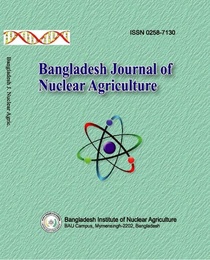BINAMORICH-1: A HIGH YIELDING MUTANT VARIETY OF CHILI USE AS SPICES, SALAD AND VEGETABLES
Abstract
With a view to develop a high yielding mutant variety of chili, 1000 seeds of the local landrace of china with low yield but highly to most of the pest and disease were irradiated with (75 Gy, 150 Gy and 300 Gy) gamma rays in 2012 at seibersdorf laboratory, Vienna, Austria. At maturity, all M1 plants were harvested and seeds were kept separately. During M2 and M3 generations, selection was conducted following high mean and high/low variances compared to the check. In M4 and M5 generations, comparative yield assessment was done in several locationsviz; Mymensingh, Ishwardi, Magura,Rangpur, Bogura, Khagrachari, Cumilla and farmer’s field in rabi season.Five true breeding lines were selected in a preliminary yield trial at M5 generation, based on plant height, number of fruits, fruit length, fruit diameter, average single fruit weight and fruit yield. Based on the same criteria, in an advance yield trial, these mutant lines were further evaluated. Of these five mutant lines, chiliD75P1 produced the highest average yield with higher fruit length and diameter than the parent line and check variety, found in both, farmer’s field and on-station trials. This chiliD75P1 has been registered as high yielding variety of chili (Binamorich-1) for commercial cultivation by National Seed Board of Bangladesh(NSB) in 2017.
References
Azad, M. A. K, Uddin, M. I. and Azam, M. A. 2012. Achievements in rice research at BINA through induced mutation. Bioremediation, Biodiversity and Bioavailability. 6 (1): 53-57.
Azad, M. A. K., Mazumdar, M. N. N., Chaki, A. K., Ali, M., Hakim , M. L., Mamun, A. N. K., Hase, Y., Nozwa, S., Tanaka, A., Koike, A., Ishikawa, H. and Azam, M.A. 2013a. Photoperiod insensitive mutants with shorter plant height identified in M1 generation of rice irradiated with carbon ion beams. SABRAO J. Breed. Genet. 45(2): 179-186.
Azad, M. A. K., Alam, M. S. and Hamid, M. A. 2013b. Modification of salt tolerance level in groundnut (Arachishypogaea L.) through induced mutation. Legume Res. 36(3): 224-233.
Dhanavel, D., Gnanamurthy, S. and Girija, M. 2012. Effect of gamma rays on induced chromosomal variation in cowpea (Vignaunguiculata L). Walp.International Journal of Current Science. Special Issue: 245- 250.
Gaul, H. 1961. Use of induced mutants in seed propagated species. In: Mutation and Plant Breeding, NAS-NRC. 891: 205-207.
Hosmani, M. M. 1982. Chilies - Mrs. Hosmani S. M. near SavonurNawab's Bunglow. Dharwad.
IAEA. 2017. Mutant Variety Database (MVD). Available at: http://mvgs.iaea.org/Search.aspx.
Mini, S., andKhader, K. M. A. 2004. Variability, heritability and genetic advance in wax type chili (Capsicum annuum L.). Capsicum Eggplant Newsletter, 23: 49-52.
Muduli, K.C. and Misra,R.C. 2007. Efficacy of mutagenic treatments in producing useful mutants in finger millet (Eleusinecoracana) Gaertn. Indian Journal of Genetics and Plant Breeding. 67(3): 232- 237.
Obidiebube, E. A., Eruotor, P. G., Akparobi, S. O., Emosaariue, S. O., Achebe, U. A., and Kator, P. E. 2012. Response of four cultivars of pepper (Capsicum frutescens L.) to different levels of NPK fertilizer in rainforest agro ecological zone. Int. J. Agri. Sci. 2(12): 1143-1150.
Oladosu, Y., Rafii, M.Y., Abdullah, N., Hussin, G., Ramli, A., Rahim, H.A., Miah, G. and Usman, M. 2015. Principle and application of plant mutagenesis in crop improvement: A review. Biotech.Biotech. Equip. 30:1–16.
Roychowdhury, R. and Tah, J. 2013. Mutagenesis–a potential approach for crop improvement. In: Hakeem, K.R., Ahmad, P. and Ozturk, M. editors. Crop improvement: new approaches and modern techniques. New York (NY): Springer. Pp. 149–187.
Smitha, R. P., and Basavaraja, N. 2006. Variability and correlation studies in chili (Capsicum annuum L.). Karnataka J. Agric. Sci. 19(4): 888-891.
Soeranto, H. 2011. Plant breeding with mutation technique (in Indonesian).Indonesian Center for Isotopes and Radiation Technology Research and Development. Jakarta: National Nuclear Energy Agency of Indonesia.
Soeranto, H., Nakanishi, T.M. and Razzak, M.T. 2001. Mutation breeding in sorghum in Indonesia. Radioisotopes. 50(5): 169-175.
-
Download



